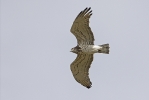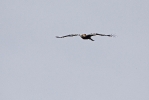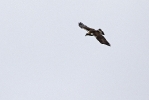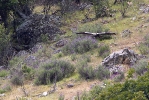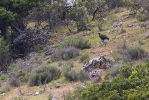I have to apologize to all those who were already looking for the kazakh trip report I had promised this past summer. Now I’m trying to make up for this.
If I had to summarize Kazakhstan raptorwise I would say that it is a must for any raptor fan. Since- except a short trip to the Tian-san- I had worked in semi-desert habitat between north of lake Balkhash and lake Alakol- mostly within a circle of 30-40 km radius- this report will refer to this area.
I had spent 2,5 months from April through June 2011 participating in an international project. Although our main target species was the Macqueen’s Bustard (Chlamidotys macqueenii) we had collected data on basically all bird species occured in the area. This short summary consists of all the data of nests and territories of raptors compiled by 10 field teams (2 people/car). I also included my personal impressions.
I listed the species in taxonomic order and I also included a few pictures of the region for our Dear Visitors to imagine easier in what habitat these species breed in this marvellous country.
1. Osprey (Pandion haliaetus): 1 ind. on migration in April
2. Oriental Honey Buzzard (Pernis ptilorhynchus): Only on migration between early May and mid-June. Max. 16 birds/ day.
3. Western Honey Buzzard(Pernis apivorus): 1 bird on May 8.
4. Black-eared Kite (Milvus migrans lineatus): One of the most common breeding and migrating species of raptors in the area. It was migrating between April and mid-May with the daily max. of 150 birds. The local breeders laid the eggs in the second half of April.
5. Pallas’s Fish Eagle (Haliaeetus leucoryphus): 1 ind. (2cy) on May 21. It was the bird of the trip for me. As far as I know there hasn’t been a proven case of breeding for decades and it’s a quite rare visitor anyway.
6. White-tailed Eagle (Haliaeetus albicilla): We only saw single birds (2 adults, 1 immature) probably migrating or just wandering about.
7. Himalayan Griffon Vulture (Gyps himalayensis): 7 birds in the Tian-san on June 23.

Extensively used pastures with high cliffs in the background suitable for nesting. That’s all what different vulture species and Golden Eagles need to breed.
(8. Griffon Vulture (Gyps fulvus): On May 8th 5 birds were soaring together with 3 Black Vultures (Aegypius monachus) but very far away and I couldn’t ID them to be 100% sure)
9. Short-toed Eagle (Circaetus gallicus): From May through June we observed 4-5 immature birds (probably 2cy) in the steppe. My ukrainian colleague Sergey Domashevsky found a nest with egg on a saxaul tree (Haloxylon ammodendron) at the height of 3m.
10. Hen Harrier (Circus cyaneus): A few migrating females and immatures in April.
11. Pallid Harrier (Circus macrourus): The most common breeding raptor species in the region. After the completion of our expedition we made a quick calculation to found that there were more than 40 pairs breeding here. During mid-April you could see displaying males everywhere which activity stopped with the start of the egg-laying season.

The kazakh steppe. The Pallid Harriers and Short-eared Owls were very common in this kind of habitat.
12. Montague’s Harrier (Circus pygargus): There were about 3-4 pairs in our study site but we could only locate territories but no nest was found.
13. Marsh Harrier (Circus aeruginosus): We only saw females and immatures migrating in April.
14. Shikra (Accipiter badius): We found 3 territories. All were int he same habitat, in riparian forests. I also heard about a pair probably breeding within a small village in a patch of trees.

Riparian habitats and saxaul forests are the only places where there is tree vegetation in this region. Black-eared Kites, Booted Eagles, Shikra were among the breeding raptors here.
15. Eurasian Sparrowhawk (Accipiter nisus): It was a quite common migrating raptor. The daily max was 10-15 birds. They migrated always alone.
16. Northern Goshawk (Accipiter gentilis): 3-4 birds migrating, all being immatures (2cy).
17. Steppe Buzzard (Buteo vulpinus): Rare migrant. We only saw a few birds in May.
18. Long-legged Buzzard (Buteo rufinus): Besides the Pallid Harrier and the Black-eared Kite it was the most numerous breeder. More than 30 pairs were found and out of these at least 3-4 pairs had one of the birds a dark phase one. There was no pair consisiting of 2 dark birds.

Long-legged Buzzard nest close to a small river.
19. Rough-legged Buzzard (Buteo lagopus): 1 adult male in the steppe on April 18th.
20. Steppe Eagle (Aquila nipalensis): The most widespread of all the ’Aquila’ eagles. About 15 pairs were nesting in the study area. Besides the local pairs one could see floaters basically everywhere (3-4 birds/day). Apart from the odd occasions of pairs nesting in totally flat habitat they normally chose hillsides with some rocks to put the nest on. Interestingly there was only one observation of displaying eagles.

During the egg-laying period the females were very tame. I experienced the same in Mongolia. Decorating the nest with garbage is common here too.
21. Imperial Eagle (Aquila heliaca): We observed one adult pair but no nest was found. This species was scarce with no more than 5-6 observation of single birds and once 2 birds together. These were exclusively 2-3cy individuals.
22. Golden Eagle ( Aquila chrysaetos): On 2 occasions we saw 1-1 birds and once an adult (probably) female.
23. Lesser Kestrel (Falco naumanni): The first birds occured at the breeding sites around the end of April. These places were normally abandoned military buildings, hangars. No colonies were found only 2-3 pairs together.

Old military hangars from the Soviet era. 2 pairs of Lesser Kestrels were breeding inside.
24. Kestrel (Falco tinnunculus): It was more common than the previous species. Regurarly occupied the nest of the Long-legged Buzzard.
25. Merlin (Falco columbarius): We saw them migrating in April and the first half of May with the max. of few birds/day.
26. Hobby (Falco subbuteo): The first birds arrived early May. Only a few pairs bred int he area.
27. Saker (Falco cherrug): The biggest and saddest surprise of all the raptors. All in all 3 breeding pairs were found and no or just one or two wandering birds were seen. At one of the breeding cliffs there was an obvious track going up to the nest as the sad proof of being well visited in the past. The only bird I saw was very similar to the birds live in Mongolia.

Although this year only Long-legged Buzzards were breeding on this hill in the background last year it hosted a pair of sakers and a pair of Eagle Owls (Bubo bubo) too.
28. Peregrine (Falco peregrinus): No breeding record from the area but a few birds were observed int he steppe.

